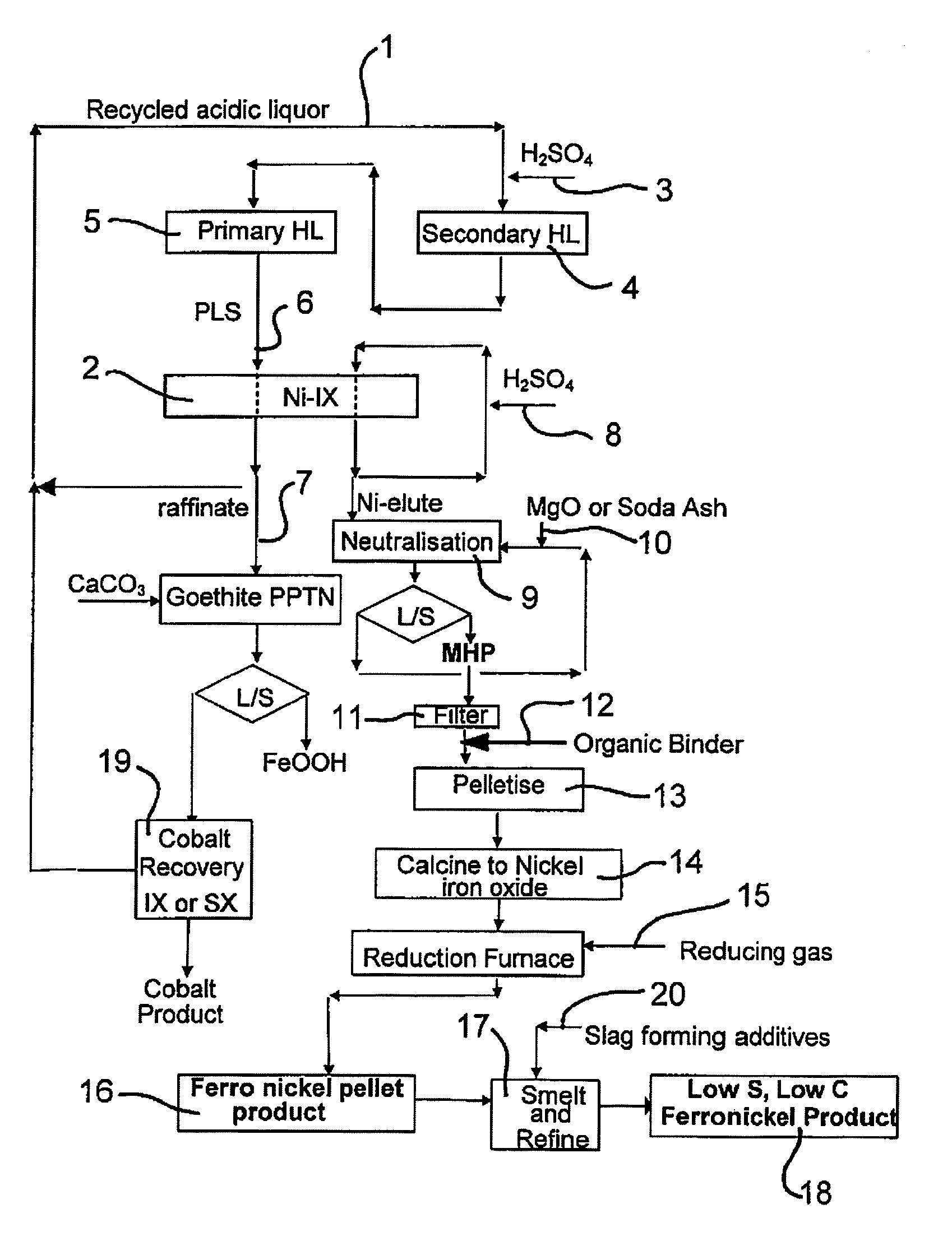Production of Ferronickel
a production method and technology of ferronickel, applied in the direction of improving process efficiency, etc., can solve the problems of low grade ores and transition ores in some deposits being rejected as waste, processing routes too expensive for these ores, and total treated ore quality, etc., to achieve the effect of reducing sulfur levels and being easy to handl
- Summary
- Abstract
- Description
- Claims
- Application Information
AI Technical Summary
Benefits of technology
Problems solved by technology
Method used
Image
Examples
example 1
Single Column Leaching with Sulfuric Acid Only
[0062] To simulate heap leaching with sulfuric acid only, 65.6 kg saprolite ore with moisture content of 20.1% was agglomerated with 98% sulfuric acid to pelletise the material with particle size of 3.35 mm to 25.4 mm. The acid dose for agglomeration was 20 kg per tonne of dry ore. The column size was 15 cm diameter×262 cm height. Sulfuric acid solution with acidity of 50 g / L was fed to column with the flux of 40 Litre / (hr.m2). The nickel extraction was 94% after 52 days. Table 3 summarizes the results.
TABLE 3Column Leaching Results with Sulfuric Acid onlyWeightkgAl %Co %Cr %Fe %Mg %Mn %Ni %Feed52.50.8120.0330.5311.016.00.1742.21oreResidue30.30.9200.0000.684.775.580.040.24Extraction %34.6110025.9674.9779.8786.7393.73
example 2
Single Column Leaching Fed with a Limonite Acid Leachate
[0063] To simulate heap leaching with acidic, nickel and cobalt containing solution e.g. pressure acid leaching PAL) or atmospheric acid leaching (AAL), 80.4 kg saprolite ore with moisture of 24.0% was agglomerated with 98% sulfuric acid to make the pellets with particle size of 3.35 mm to 25.4 mm. The acid dose for agglomeration was 25 kg per tonne of dry ore. The column size was 15 cm diameter×386 cm height. The acidic leachate from a limonite pressure leach containing nickel, cobalt and iron in solution, was fed to the column with a flux of 10 Litre / (hr.m2). The composition of this feed solution is shown in Table 4. The nickel extraction was 76% at 197 days. Table 5 summarizes the results.
TABLE 4Composition of limonite acid leachateAcidityAlCoCr(VI)FeMgMnNig / Lmg / Lmg / Lmg / Lmg / Lmg / Lmg / Lmg / L30-4045507303503450475039908550
[0064]
TABLE 5Column Leaching Results with Acidic leachateWeightkgAl %Co %Cr %Fe %Mg %Mn %Ni %Feed ore61.11...
examples 3
Counter-Current Leaching
[0065] In order to simulate the counter current leaching process, a group of counter-current column leaches were carried out with a constant acid consumption of 670 kg H2SO4 / t ore. The group contains five columns named as A, B, C, D and E. Column A was firstly fed with acidic intermediate product liquor solution (IPLS) obtained from previous column leaching (simulating the secondary leach effluent liquor) to simulate primary leaching, then fed with blank sulfuric solution of 100 g / l H2SO4 to simulate secondary leaching, and finally rinsed with pH 2 dilute H2SO4 solution. The Product liquor solution from the primary leaching was stored for nickel recovery with IX. The IPLS from the secondary leaching and rinsing was used as feed solution to column B as primary leaching and so-on. Only the results of column B, C, D and E are quoted because these columns had the same initial conditions. The operation time of each column was about 30 days.
[0066] 26 kg saprolite...
PUM
| Property | Measurement | Unit |
|---|---|---|
| Temperature | aaaaa | aaaaa |
| Temperature | aaaaa | aaaaa |
| Temperature | aaaaa | aaaaa |
Abstract
Description
Claims
Application Information
 Login to View More
Login to View More - R&D
- Intellectual Property
- Life Sciences
- Materials
- Tech Scout
- Unparalleled Data Quality
- Higher Quality Content
- 60% Fewer Hallucinations
Browse by: Latest US Patents, China's latest patents, Technical Efficacy Thesaurus, Application Domain, Technology Topic, Popular Technical Reports.
© 2025 PatSnap. All rights reserved.Legal|Privacy policy|Modern Slavery Act Transparency Statement|Sitemap|About US| Contact US: help@patsnap.com



